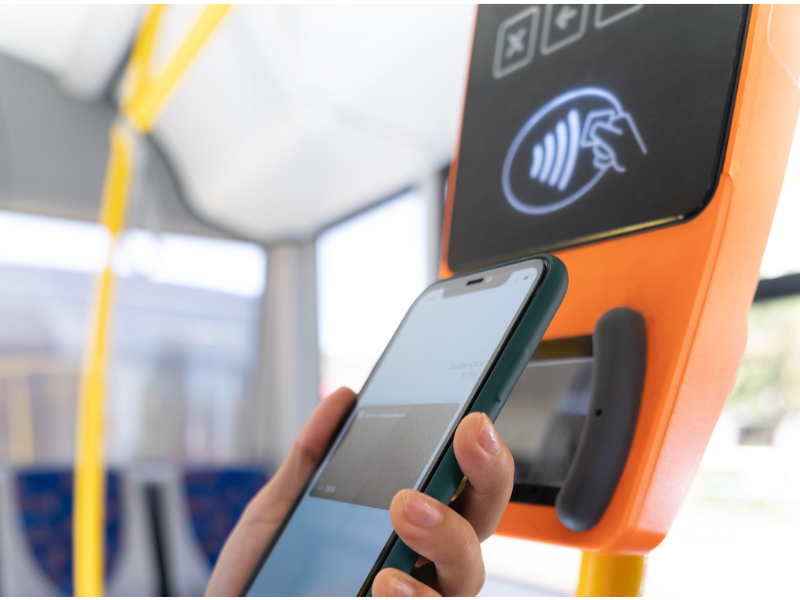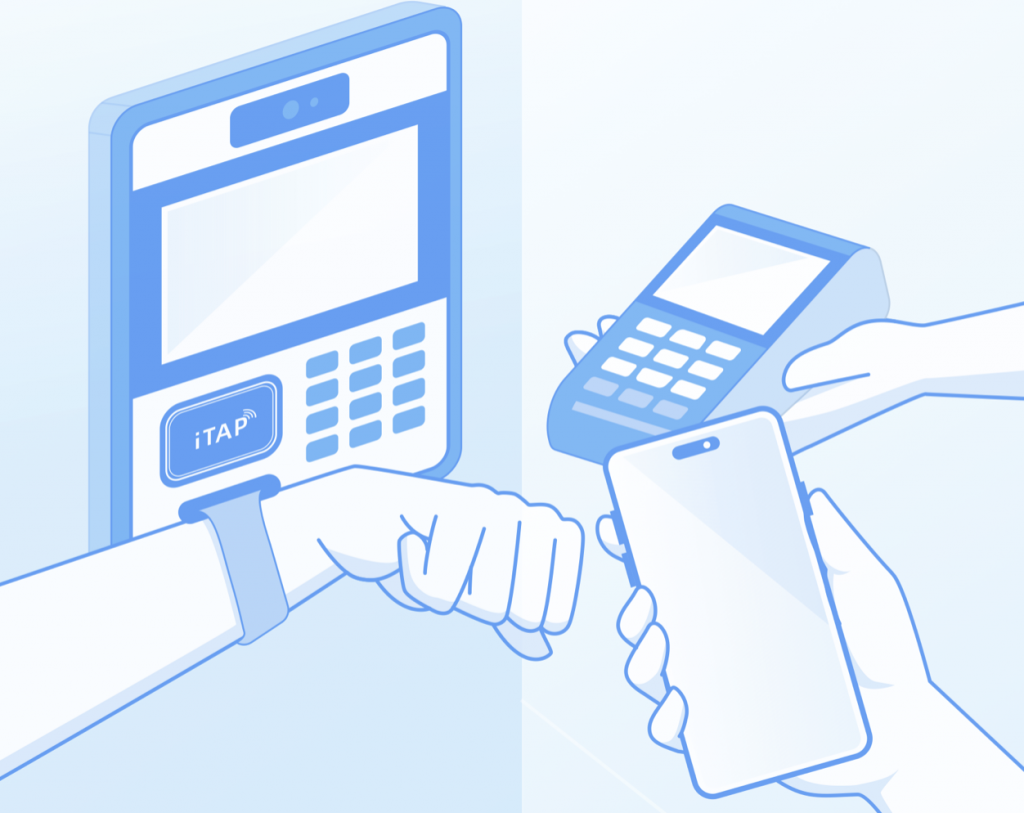- iTap enhances NFC technology by increasing transaction speed, security through dynamic encryption and tokenisation, and scalability across industries.
- China is actively promoting iTap as a global standard and incorporating it into its smart city and digital economy programmes. Collaborations with companies such as Alipay and Huawei are driving the widespread adoption of iTap in areas such as public services, transport and healthcare.
Imagine walking into your favorite coffee shop on a busy morning. There’s a long queue, the barista is rushing, and you’re running late. You pull out your phone and tap the payment terminal. In less than a second, your coffee is paid for. No cards, no passwords—just a quick, seamless transaction. This is what Alipay’s tap-to-pay offers.
According to Alipay, over 77 cities in China, including Beijing and Shenzhen, have installed tap-to-pay devices. Sixty-three percent of young users have already tried it. The tap-to-pay function is also available in over 100,000 restaurants, making it more convenient for both customers and merchants.
While NFC payments aren’t new, Alipay’s tap-to-pay does more than speed up transactions—it also makes them safer, smarter, and more efficient. It’s setting a new payment standard with iTAP (Intelligent Tap Protocol).
Also read: Understanding near field communication
Also read: Tyro launches embedded payments to simplify transactions
What is iTap? The new standard for NFC technology
Originating from RFID technology, NFC is able to achieve fast and efficient data exchange within centimetre-level distances, and is widely used in areas such as mobile payment, access control and tag reading. However, the NFC standard launched in 2001 only supports unidirectional information transmission, which is unable to meet today’s diversified digital applications and market demand, and there are problems such as multi-card selection, slow transaction speed, security risks and insufficient merchant scalability, resulting in low multi-scenario ubiquity.
The emergence of the iTap protocol is expected to solve these problems and drive the further development of NFC payment technology. iTap is not just a payment solution, it is an advanced communication protocol that transforms the NFC payment experience by improving transaction speed, security and scalability, and is even applicable to other areas of fast, secure data transmission.

Faster transaction speeds
One of iTap’s core benefits is significantly faster transaction speeds. While traditional NFC payment systems are already faster in most cases, slight delays can still occur in high-traffic environments. iTap dramatically reduces transaction delays by optimising the communication protocol between devices so that payments are completed almost instantaneously, making it particularly suitable for public transport and high-traffic retail environments.
Superior security
Security is another key feature of iTap. Traditional NFC payment systems use static encryption keys, which can be vulnerable to cyber-attacks. iTap, however, uses dynamic encryption. It generates a unique encryption key for each transaction, which reduces the risk of data leakage and fraud. Additionally, iTap employs tokenization, replacing sensitive payment information with one-time-use tokens. This means that even if the device is compromised, malicious actors cannot access the user’s financial data.
Also read: Why is encryption important for data security?
Cross-industry scalability
The iTap protocol not only improves the payment experience but also offers excellent scalability. It provides a unified specification for various industries, helping merchants and device vendors reduce integration costs. This allows organizations to easily adopt secure and efficient NFC payment solutions without needing significant infrastructure investments. The protocol is also compatible with existing NFC systems, making it easy for small merchants, government agencies, and large enterprises to adopt. This sets the stage for global adoption. The iTap standard will drive the future of consumer payments, digital IDs, transportation, tourism, e-ticketing, anti-counterfeiting, traceability, and smart access control.
The iTap protocol will address ecological pain points through technological innovation, providing accurate card selection functions and intelligent terminal-driven multi-scene interaction.
Qin Yao, Vice President of Huawei Device
Pop quiz
Which technology does iTap use to enhance security?
A. Static encryption keys
B. Dynamic encryption and tokenization
C. Biometric authentication
D. Blockchain technology
The correct answer is at the bottom of the article.

China’s strategic initiatives in promoting the iTap protocol
China is pushing the iTap protocol as a global standard, key to its smart cities and digital economy strategy. In 2024, the government launched digital payment and IoT integration programs to position China as a global leader in the digital economy. iTap supports these initiatives and is becoming vital for smart city projects and digital infrastructure. It will play a key role in urban planning, logistics, and public services, driving a more efficient, secure, and connected future.
In December 2024, China released the first technical whitepaper on iTap, developed with input from companies like Huawei, Alipay, and CNISET. This was marked by the iTap Eco Launch Ceremony in Shenzhen, signalling a new era for NFC technology. The iTap 1.0 standard is set for release in mid-2025, with testing and compatibility checks to ensure large-scale adoption.
Ant Group, Alipay’s parent, is working with government and industry partners to expand iTap’s use across sectors. Alipay’s “Tap-to-Pay” service already uses iTap’s NFC tech to enhance payment experiences. Once the standard is released, Alipay will fully support iTap, with pilots in smart cities showcasing its potential in transport, utilities, healthcare, and public safety.
Huawei’s Qin Yao noted that iTap will address issues like card selection and multi-scenario interactions. Huawei plans updates to its Mate and P series phones for iTap support and is collaborating with Alipay on “screen-on-to-pay” via facial recognition. As AI and secure payments grow, China is fast-tracking self-controlled payment systems, with chip makers crucial to building the iTap ecosystem and advancing China’s digital payments and IoT leadership.
Also read: Putin directs Russian bank to partner with China on AI
Also read: China drives Bluetooth alternative as universal remotes rise
The commercial promotion of the iTAP standard includes two key paths: one is to improve technical performance to ensure security and stability; the other is to promote cross-field technology integration and expand international applications.
Wang Wenjian, Deputy Director, China National Radio Monitoring Centre (CNRMC)
Global impact: How iTap is changing industries beyond payments
While mobile payments remain the primary use case for the iTap protocol, its true potential lies in its widespread adoption across multiple industries. iTap is reshaping the way we connect, share data and interact with the world around us. With iTap, digital infrastructures will become smarter, safer and more efficient, transforming not only the way we shop on a daily basis, but also the way cities, healthcare systems and industries operate. This is the next leap in the evolution of digital transactions.

Smart cities
iTap will play an important role in smart cities. As cities increasingly adopt connectivity technologies, the need for instant and secure data transfer becomes critical. iTap’s ability to provide real-time information transfer with a high degree of security makes it ideal for applications such as intelligent transport systems, smart utility management and public safety. For example, smart parking meters can communicate instantly with the control centre, and citizens can pay for public services with a single ‘tap’.
In addition, iTap will facilitate the development of smart infrastructure, such as self-driving vehicles, which require fast and secure data exchange for real-time coordination and safety management.
Also read: Exploring the future of urban life: Key characteristics of smart cities
Also read: 12 benefits of smart cities
Healthcare
iTap has great potential in the healthcare industry. Medical data, including patient records and real-time health monitoring, must be transmitted securely. The encryption technology in iTap ensures that sensitive medical data is safely shared across platforms. This improves patient care while meeting strict data protection regulations.
Moreover, iTap-based wearable health devices can send a patient’s health data to hospitals in real-time. This helps healthcare professionals make quick decisions and respond to emergencies. It has the potential to transform chronic disease management and emergency medical services.
Also read: How is digital transformation changing the healthcare industry?
Digital identity and authentication
As the world transitions to a digital identity system, iTap will play a key role in secure authentication. In areas where Electronic Key Yield Certificate (eKYC) has been implemented, iTap’s high-security protocols enable seamless and secure authentication not only in the banking sector, but also in areas such as the government sector.
Users will be able to verify their identity and conduct secure transactions with a single touch, which will greatly simplify scenarios such as online banking, digital government services, border control and secure access control.

Looking ahead
As the iTap protocol continues to expand across industries, its potential reaches far beyond just mobile payments. With its ability to drive faster, safer, and more scalable data exchanges, iTap is positioning itself as a cornerstone of next-generation smart cities, healthcare, and digital infrastructure. As China leads the charge in promoting iTap as a global standard, the protocol’s integration into everyday life—from transport and public services to digital identity and healthcare—will bring about a more efficient, secure, and connected world. The anticipated release of iTap 1.0 in 2025 marks the beginning of a new era for NFC technology, promising to revolutionise how we interact with the world around us. As the ecosystem grows, iTap’s adoption will play a critical role in shaping the future of digital connectivity, making everyday transactions smoother and more secure while enabling the smart infrastructures of tomorrow.
FAQ
The iTap protocol is a new near-field communication (NFC) technology standard designed to improve transaction speed, security, and scalability. It is not just for payments but can be used across multiple industries for fast, secure data transmission, supporting the development of smart cities and the digital economy.
The iTap protocol optimises the communication protocol between devices and uses dynamic encryption, significantly improving transaction speed and security. Unlike traditional NFC systems, iTap enables almost instantaneous payments, making it ideal for high-traffic environments like public transport and retail while reducing risks such as data leakage and fraud.
iTap is not only suitable for digital payments but also applies to a wide range of industries, including smart cities, IoT, transportation, healthcare, and public safety. Its efficiency and security make it a crucial technology for digital transformation across various sectors.
Chip manufacturers are crucial in supporting the development of the iTap ecosystem by producing the necessary hardware that supports iTap’s smart NFC technology. Their involvement will help drive the adoption of iTap across industries, enhancing China’s leadership in global digital payments and the Internet of Things (IoT).
The iTap protocol has a promising global outlook, especially as China accelerates its digital economy and smart city initiatives. With the release of the iTap 1.0 standard in 2025, iTap is expected to drive innovation in payment solutions, IoT, and other sectors, with widespread adoption expected globally, further enhancing China’s leadership in digital payments and smart technology
Quiz answer
B. Dynamic encryption and tokenization
